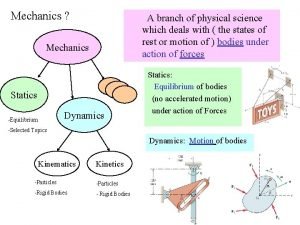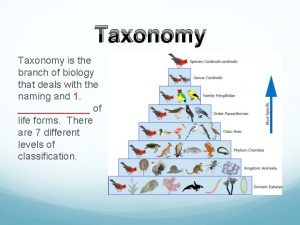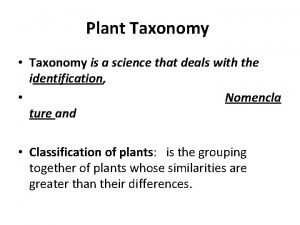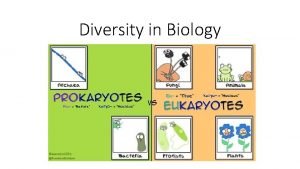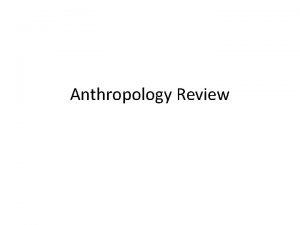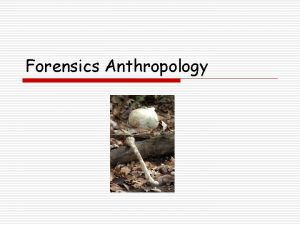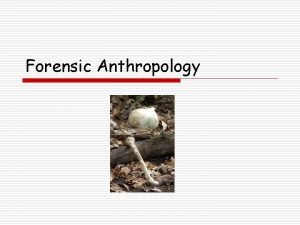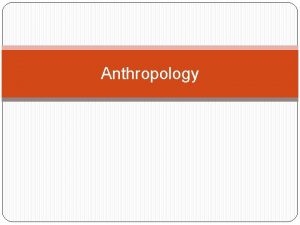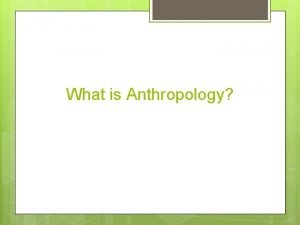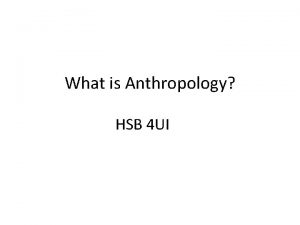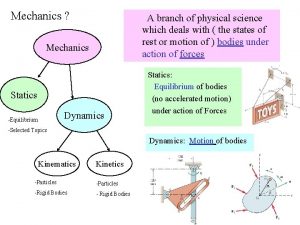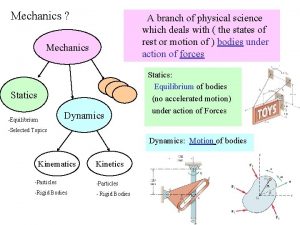Anthropology Anthropology is the science which deals with






















- Slides: 22

Anthropology ?

Ø Anthropology is the science which deals with the study of origin and development of the human beings. Ø The term anthropology is derived from two Greek words “Anthropos” meaning man or human and “Logos” meaning study Ø It means anthropology is the study of man or human beings. Ø The concept of Anthropology is led by the Franz Boas (1858 -1942) and is known as the father of modern American Anthropology

Contd. Ø Anthropology always tries to seek or discover when, where, and why humans are appeared in the earth Ø How and why they have changed since then and how and why modern human populations vary in certain physical features Ø Let us see the position of Anthropos (Homo sapiens/human beings/man) in the animal kingdom:

Contd. Division Grade Phylum Sub phylum Class Sub Class Order Sub order Super family Family Genus Species Location Metazoa Chordata Vertebrata Mammalia Eutheria Primate Anthropoidea Homonidea Homo Sapiens

Contd. Ø According to Jacobs and Stern “ Anthropology is the scientific study of the physical, social and cultural development and behavior of human beings since their appearance on this earth” Ø According to A. L. Kroeber “Anthropology is the science of group of men, their behavior and production” Ø Similarly, according to M. J. Herskovites “Anthropology is the study of man and his works” Ø It is further defined by the Hoebel as “Anthropology is the study of the man and all his works”

Nature of Anthropology Ø Anthropology is a dynamic subject, characterized by rapid change and diversification. So that the present statement or any similar exercise, can only represent a rough mapping at a particular moment in time. Ø Anthropology as a subject is concerned with the study of the social, cultural and biological diversity of humans. Ø Anthropology can be divided in to a number of specializations although the boundaries between these are rarely exclusive and change over time. Ø Anthropology is the multifaceted study of humans and their ways of life from a global and evolutionary perspective.

Scope of Anthropology Ø Anthropology is broader in scope both geographically and historically Ø Anthropology is concerned directly with all varieties of people throughout the world, not within a limited area. Ø Anthropology puts interest to study in peoples of all periods, beginning with the immediate ancestors of human who lived few million years ago. Ø The field of anthropology retains its holistic orientation in that its many specialty/field, taken together, describe many aspects of human existence, both past and present Ø Anthropology is the all inclusive human science and can take broader space for the study.

Sub-Division/branches of Anthropology 1. Physical Anthropology Deals with the bodily characteristics of early man and our primitive contemporaries i. Anthrometry ii. Human biology (Genetics) iii. Human paleontology (Study of fossils) 2. Cultural Anthropology Investigates the cultural remains of early man and of the living cultures of some of the primitive contemporaries i. Prehistoric archaeology (Cultures of prehistoric period) ii. Ethnology (Study of cultures) iii. Linguistics

Contd. 3. Social Anthropology Deals with the relationships between institutions and human beings 4. Applied Anthropology Deals with: the application of method and theory in anthropology to the analysis and solution of practical problems with using anthropological data, perspectives, theory and method

Relation viz. differences between Sociology and Anthropology Sociology Mainly a study of modern communities Makes use of documents and statistical methods Anthropology Mainly a study of ancient communities Makes use of the functional methods Social science Natural science Methods of social Methods of natural science

Cont. Limited study of anatomical characteristics Is concerned with influence of anatomical features up on social relationships In addition to studying social problems, it makes suggestions for their solutions Detail study of anatomical characteristics Is not concerned with influence of anatomical features up on social relationships Studies social problems but does not make suggestions for their solution.

Historical development of Sociology and Anthropology in Nepal The historical development of sociology and anthropology in Nepal is directly concerned with the appearance of human settlements and subsequent development of human societies in the ancient period from the very beginning It is not only in the valleys but again in the high Himalayan regions and southern terai belts also in Nepal

Contd. The history starts from the point of arrival of men and their associated cultures, different social functions and behaviors Nepal, a small Himalayan country sandwiched between India and China, is a cultural mosaic (variety/mixture) forming a unique kind of multi-ethnic and caste society, throughout its history.

Contd. There about 140 distinct ethnic/caste groups, who have lived side by side for the past 2, 000 years, maintaining separate yet related cultural traditions of their own. Racially, two distinct groups of people in Nepal: the Indo-Aryan and the Mongoloids More specifically Nepalis are descendants of migrants from parts of earlier Greater Nepal, Tibet, India and parts of Burma

Contd. Among the earliest inhabitants were the Kirat of east mid-region, Newar of the Kathmandu Valley and aboriginal Tharu in the malarial southern Terai region. The ancestors of the Khas (Bahun, Chhetri, Thakuri, Sanyasi) migrated eastward along the himalayan foothills out of Kasmir, Kumaon , Garhwal-- parts of then Greater Nepal , Karnali Pradesh (Nepal) and perhaps also north from the Gangeatic Plains during invasions

Contd. Other ethnic groups trace their origins to North Burma, and Tibet, e. g. the Gurung and Magar in the west, Rai and Limbu in the east, and Sherpa and Bhotia in the north. In the Terai, much of the population is physically and culturally similar to the Indo-Aryans of northern India It is obvious that of all the Nepali people, Newars observe the greatest number of festivals and feasts including Yamari and the Guthi is one of the strong local institution within Newars.

Contd. Others also have similar nature like Gurung- Rodhi, Magar- Bheja, Sherpa- Loshar, Christian. X-mas, Brahman/Chhetri- Dashain/Tihar and Terai people- Chhaith etc. When we look back to the history, many things have been changed, modified and developed in different time frame in all the matter of sociological and anthropological study

Contd. Change and development has been occurred basically in worshipping the god, marriage, food habits, cloths and fashion, behavior etc. In the academic field and major development discourse, the sociological concerns had been developed only after the 1953 and similarly anthropology in 1970 in Nepal. These all summarized features are the real state of historical development of sociology and Anthropology in Nepal.

Demography is the term derived from the two Greek words “Demos” - People “Graphy” - Study. Therefore, demography is the study of people means population. It is the study of population. The term demography was first used by Guillard in 1855 and now a days denotes the study by statistical methods of human population.

Contd. This involves primarily the measurement of the size and growth of the numbers of people Guillard defined demography as “ The natural and social history of the human species or knowledge of population and their general changes , physical, civil, intellectual and moral condition According to Hauser & Duncan “ Demography is the study of the size, territorial distribution and composition of population, changes there in , and the composition of such changes, which may be defines as natality, mortality, territorial movements and social mobility”

Contd. There is practical value in measuring population growth so as to be able to plan ahead for satisfying man’s needs throughout life- food, clothing, shelter, and other necessities. Demographic data may facilitate the making of arrangements for the ascertainment of peoples views on important topical questions, the election of representatives governing bodies, the collection of taxes, the provision of social services.

For example, population of Nepal (CBS, estimation 2008) Population: 29, 519, 114 (July 2008 est. ) Age structure: 0 -14 years: 38. 7% (male 5, 648, 959/female 5, 291, 447) 15 -64 years: 57. 6% (male 8, 365, 526/female 7, 925, 941) 65 years and over: 3. 7% (male 513, 777/female 541, 497) Median age: 20. 3 years Growth rate: 2. 17% Infant mortality: 65. 32 deaths/1, 000 live births Life expectancy at birth: total population: 60. 18 years male: 60. 43 years female: 59. 91 years
 Thermodynamics is a branch of science which deals with
Thermodynamics is a branch of science which deals with Hydrology is science which deals with
Hydrology is science which deals with Principle of transmissibility
Principle of transmissibility Taxonomy is the branch of science that deals with –
Taxonomy is the branch of science that deals with – King philip coughed on fred
King philip coughed on fred Loculicidal capsule fruit
Loculicidal capsule fruit Crayfish taxonomy
Crayfish taxonomy What is her favourite subject?
What is her favourite subject? Hình ảnh bộ gõ cơ thể búng tay
Hình ảnh bộ gõ cơ thể búng tay Lp html
Lp html Bổ thể
Bổ thể Tỉ lệ cơ thể trẻ em
Tỉ lệ cơ thể trẻ em Chó sói
Chó sói Tư thế worms-breton
Tư thế worms-breton Bài hát chúa yêu trần thế alleluia
Bài hát chúa yêu trần thế alleluia Môn thể thao bắt đầu bằng chữ f
Môn thể thao bắt đầu bằng chữ f Thế nào là hệ số cao nhất
Thế nào là hệ số cao nhất Các châu lục và đại dương trên thế giới
Các châu lục và đại dương trên thế giới Cong thức tính động năng
Cong thức tính động năng Trời xanh đây là của chúng ta thể thơ
Trời xanh đây là của chúng ta thể thơ Mật thư anh em như thể tay chân
Mật thư anh em như thể tay chân 101012 bằng
101012 bằng Phản ứng thế ankan
Phản ứng thế ankan


